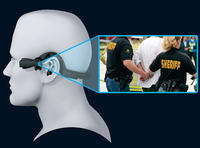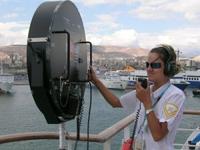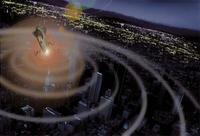-
Taser rolls out redesigned wearable cameras

Last week Taser, the manufacturers of the electric stun guns, unveiled its newly remodeled wearable camera system which is sleeker and more advanced than its predecessor; the Axon Flex, introduced less than a year after the company rolled out its first wearable cameras, represents a significant upgrade
-
-
Protests spur sonic blaster sales boom

With the spate of protests from the Occupy Wall Street movement sweeping across the country, there has been a surge of interest in non-lethal crowd control systems; in particular U.S. police and first responders have taken a keen interest in Long-Range Acoustic Devices (LRAD)
-
-
Nonlethal microwave weapon successfully tested

Counter-electronics High-powered Microwave Advanced Missile Project (CHAMP) is a nonlethal alternative to kinetic weapons that neutralizes electronic targets; it would allow the military to focus on these targets while minimizing or eliminating collateral damage; Boeing and the U.S. Air Force have successfully completed the missile’s first flight test
-
-
Why the Twin Towers collapsed: new theory
Materials scientist says that a mixture of water from sprinkler systems and molten aluminum from melted aircraft hulls created explosions that led to the collapse of the Twin Towers on 9/11
-
-
Taser-related fatalities raise safety concerns

As police across the United States increasingly turn to Taser guns as a non-lethal weapon, the device’s safety has come under scrutiny following several recent deaths involving Tasers; last week the Fayetteville police department in North Carolina recalled all of its Taser M26 units following the death of a fifty-six year old political activist who died after being stunned by police
-
-
Wastewater recycling adds to greenhouse gas emissions

New research shows that wastewater recycling processes may generate more greenhouse gases than traditional water-treatment processes; still, there are good reasons to continue keep wastewater recycling among the water-resource tools for urban areas
-
-
Taser death leads to $10 million payout
The manufacturer of police Tasers recently awarded $10 million to a North Carolina family after a teenager was killed when he was shocked with a stun gun; Darryl Turner, a seventeen year old boy, died in a supermarket after a police officer shot him in the chest with a Taser Model X26 electronic control device in 2008
-
-
Tough new Alabama immigration law divides community
A sweeping new Alabama immigration law is generating sharp controversy and unease with many likening it to a return to the state’s brutal Jim Crow laws; among the strict immigration measures passed last month, undocumented immigrants are banned from enrolling in or attending college, applying for work, and landlords are restricted from renting property to illegal aliens; the law even requires school districts to check the immigration status of children; the bill has drawn fierce criticism from immigration advocates, churches, and civil liberties groups.
-
-
Strong fabric can be used to protect buildings from explosion
Carbon fiber reinforced polymer (CFRP) is a fabric that can carry 143,000 pounds of force per square inch; University of Missouri researcher collaborates with the U.S. Army to test a method of retrofitting buildings to protect them in the case of a terrorist attack; to protect a building from an extreme event, CFRP can be used to increase the bending capacity of walls or columns
-
-
Innovative decontamination cloth reaches market
A new decontamination cloth, developed for use by soldiers and first responders, is now available in several forms — as preshaped mitts for personal wipedowns if someone is exposed to toxins or chemicals, individual wipe cloths and pads, and in rolls perforated to produces 12-inch by 12-inch sheets, like paper towels in a kitchen
-
-
New non-lethal weapon against terrorism: spicy pepper

Classic Tabasco sauce ranges from 2,500 to 5,000 Scoville units (the scientific measurement of a chili’s spiciness), while jalapeno peppers measure anywhere from 2,500 to 8,000 Scoville; India’s bhut jolokia has more than 1,000,000 Scoville units, and it is accepted by Guinness World Records in 2007 as the world’s spiciest chili; the Indian military has now developed a bhut jolokia hand grenade to be used against unruly mobs and to flush out hiding terrorists
-
-
U.K. police to use tasers on unruly rib-pokers
Last December, some 180 protesters, most aged between 17 and 25, stood in front of the Royal convoy, and some protesters began to kick, hit, and hurl objects at the Royal car; as the Duchess of Cornwall sat in the vehicle, she was poked in the ribs with a stick through a window slit; demonstrators pursued the envoy, chanting “Off with their heads”; to prevent such occurrences in the future, the U.K .Diplomatic Protection Squad will be supplementing their conventional firearms with stun guns
-
-
Non-lethal weapons in the wild
Taser International has unveiled a Taser stun gun designed for use on large animals; it can temporarily incapacitate mammals like bears and moose and is designed to increase the safety of wildlife workers and park rangers; the laser-sighted weapon is based on the company’s most advanced police Taser, the X3, but is optimized to work on large animals with thick hides
-
-
U.S. kill vehicle missile defense weapon fails test
The U.S. Missile Defense Agency has suffered another failure in a live test conducted last week over the Pacific; the first part of the test — detecting and tracking the “enemy” missile by the Sea Based X-band Radar — went well; the second part — getting an Exo-atmospheric Kill Vehicle (EKV) to place itself in the path of the oncoming missile warhead and destroying it — did not work; the Ground Based Interceptor (GBI) triple-stage rocket is the most capable tool in the U.S. Missile Defense Agency’s armory, but its test record is spotty at best
-
-
Israel shoots down motorized, unmanned balloon near Dimona nuclear reactor
Israel Defense Force spokesperson says that Israel Air Force warplane shot down an object — a motorized unmanned balloon — in the south of Israel; the balloon was shot down as it approached the Dimona nuclear reactor; the area is a strict no-fly zone; planes or other objects entering it are shot down first, with questions being asked later; during the 1967 Six Day war, an Israeli surface-to-air missile downed a crippled Israeli fighter-bomber that strayed into the restricted zone while returning from action on the Egyptian front; its pilot was killed
-
- All
- Regional
- Water
- Biometrics
- Borders/Immig
- Business
- Cybersecurity
- Detection
- Disasters
- Government
- Infrastructure
- International
- Public health
- Public Safety
- Communication interoperabillity
- Emergency services
- Emergency medical services
- Fire
- First response
- IEDs
- Law Enforcement
- Law Enforcement Technology
- Military technology
- Nonlethal weapons
- Nuclear weapons
- Personal protection equipment
- Police
- Notification /alert systems
- Situational awareness
- Weapons systems
- Sci-Tech
- Sector Reports
- Surveillance
- Transportation
Advertising & Marketing: advertise@newswirepubs.com
Editorial: editor@newswirepubs.com
General: info@newswirepubs.com
2010-2011 © News Wire Publications, LLC News Wire Publications, LLC
220 Old Country Road | Suite 200 | Mineola | New York | 11501
Permissions and Policies
Editorial: editor@newswirepubs.com
General: info@newswirepubs.com
2010-2011 © News Wire Publications, LLC News Wire Publications, LLC
220 Old Country Road | Suite 200 | Mineola | New York | 11501
Permissions and Policies
